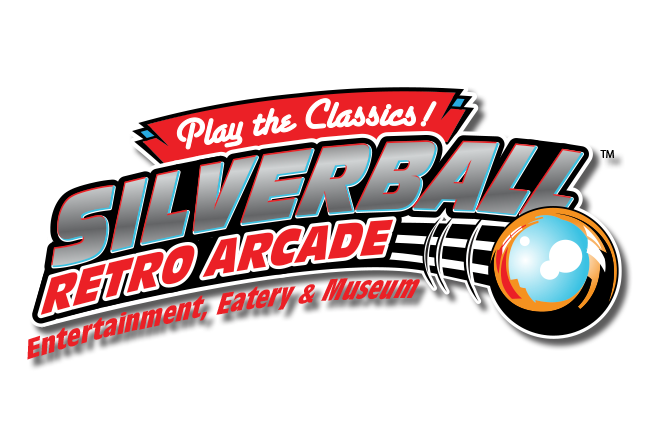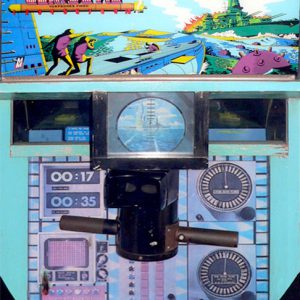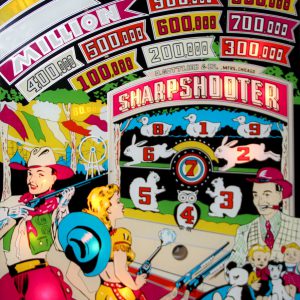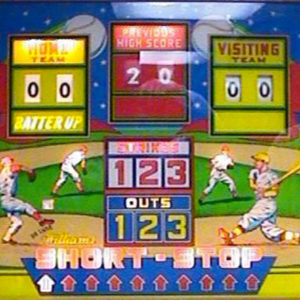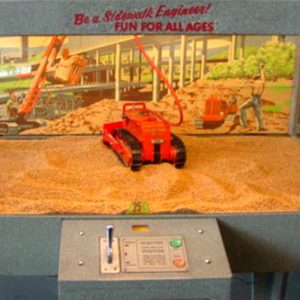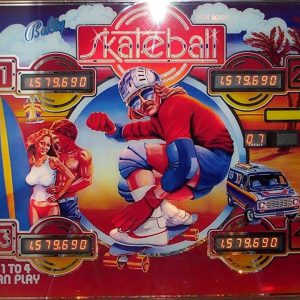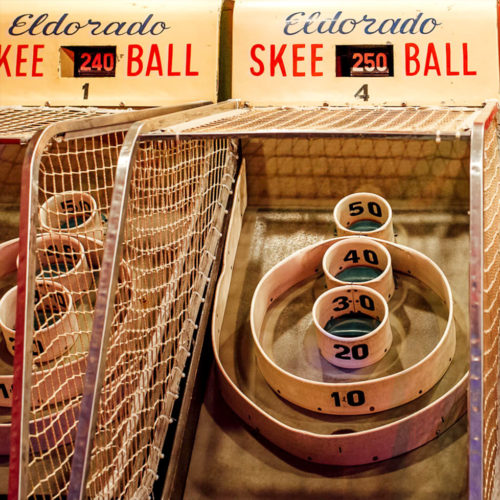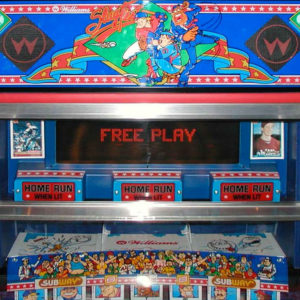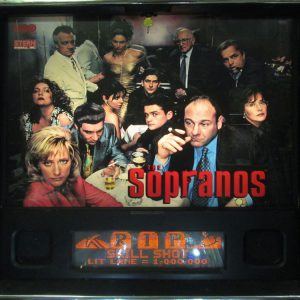-
This was one of my favorite arcade machines in its heyday. Midway found much success with this one-player machine. A faux periscope is the viewing platform for action in this battle to sink enemy ships. You are allowed a fixed number of torpedoes per game to sink as much tonnage as possible per outing. A perfect game awards bonus torpedoes. The lighting effects and sounds are wonderful for their day. You’re allowed to “steer” your torpedo to about one-fourth of theway to your enemy. Giving just the right amount of lead time to each ship is critical. Some shipsare faster than others and these sinkings award more points. Go ahead, captain, sink the fleet!Sharp Shooter is an EM Rifle game. The shooter can choose from a variety of targets in a well-decorated range, which uses black lights to make some interesting pictures. The shooter can choose from candles, tumbling acrobats, bicycle-riding clowns, ducks and a bonus bullseye. The candles are worth 200 points; the bonus target switches from 100-200-300 points; and the other targets vary shot by shot from 30-50-100 points. The game has provisions for setting the replay score, number of shots per game and a random-miss factor and a recoil solenoid. The game also has electronic sounds such as ducks quacking.This Williams machine fabricated in 1955 is a strange game that really is more of a toy. A player gets to operate a remote-controlled bulldozer around a big sandbox for 120 seconds using two remote controllers in synthetic gravel. It appears the idea for this machine was to cater to the under-12 market as no rewards, extra time, or extra plays were programmed into the electromechanical boards within the machine. No scoring and no prizes! This machine was often confused with Williams’ Crane (1956) because it has a sign on top of the game that says, “Be a sidewalk engineer.” Ten cents allowed adults a two-minute break to get a quick snack while a child was entertained. I don’t think this would be the case in today’s thinking…10,350 of these machines made it through the doors of Bally in 1978. Designed by the great Jim Patla and art package by Kevin O’Conner, this early wide body machine is a perfect match for the pinball trade as well as this museum. Even though it was made prior to vocalization in pinball machines, the sounds of the machine draw one in to play its features. All the technology of the 70s is present here with drop targets, loop shots, advancing bonus features and a novel kick back kicker between the flippers which, once achieved, brings the ball back into play instead of draining. Completing the spelling of “Silverball Mania” advances the bonus features. If you complete this feat three times in a game, a built in carrier feature advances on the backglass and awards an operator-adjustable reward, classically three free games. A great playfield flow was designed into the game with two “back to the top” shots enticing players along.Claude Fernandez designed this machine at Bally with the infamous Greg Freres penning the artwork early in his career. 4,150 examples of this game were screwed together. This machine’s asymmetrical playfield is classic Bally. Lane change at the top of the playfield via flipping is a first on this machine. By dropping the targets to spell “skate”, one advances the kickout hole to advance. After three or four advances, extra ball and special light. Hitting “skate” and A and B at the bottom of the playfield light extra ball. The center drop targets advance the value of the targets when all lit, all the way to 100,000 points. If you are skillful enough to advance the bonus to its highest point, the specials light up. This Bally game is also the first machine to have seven-digit scoring!This roll-up game is a classic which originated in 1909 in Philadelphia, Pennsylvania. It is one of the first redemption games ever made, with tickets being awarded as higher and higher scores are achieved. Batteries of these machines were a common staple on every boardwalk down the Jersey Shore. Nowadays, the game is still being made and is popular for all ages. The newest twist with the popularity of these machines is the formation of leagues which, like bowling, compete for trophies and bragging rights. Players go by the name of Ski-diddies, and a recent competition was televised on ESPN . These games are relatively easy to cheat on, by dropping balls in the high-scoring holes. That’s why the nets were incorporated into the design of more contemporary machines to limit this activity.This April release was produced in a quantity of 4,550 units. Wayne Neyens designed the machine with Roy Parker doing the artwork. The art theme of the machine is Playboy bunnies as the Playboy Corporation opened a big Playboy club in the Chicago area in 1960 which was a real hit. The object of the game is to light the bumpers spelling out “Slick Chick.” It’s a tough game to master. Each time the sequence is completed, a rollover lights on the play field to score 10 points. If you can complete all five roll-overs, the center gobble hole lights to score a replay. Four roll-overs on the side of the play field numbered one to four also score a replay if hit in sequence. Score is your other goal toward replays. I remember playing this game at the arcades and it was very hard to achieve a winning combination. It is considered one of Wayne Neyens’ best games and one of his favorites in the annals of pinball design.This game is the pinball rendition of the HBO TV show, The Sopranos, complete with voices of most of the actors in the series. It was designed by George Gomez with the art package created by Kevin O’Conner. The main object of the machine is to advance through the ranks of the mob by advancing your status through playfield rollovers and cracking the safe. Doing so is difficult to achieve to top capo. A multiball feature is also incorporated into the game behind a solo drop target. Video modes must be achieved to complete the placard of events culminating in the completion of your missions. So many pop bumper hits light up the party at the bing in the upper right, which scores a bunch of points. Mastering this machine is tough, but that’s what brings you back to try again.Space Mission was released in January, designed by Steve Kordek with artwork by Christian Marche. Production run was 11,652. This game was very successful for Williams and is considered to be the seventh most desirable game of the ’70s era.The game features a moving target as well as two side kickers next to the flippers for shots at the moving target. Making the A, B, or C light up the side eject holes to award a double bonus for the ball in play. If you were skillful enough to complete the A, B and C, the side outlanes light up for special. The top horshoe loop advances the bonus system. This game has a lot of nice shots and is fast paced. One doesn’t tire easily trying to achieve the scores needed to win a free game. This game was one of Steve’s Kordek’s favorite designs.
-
This was one of my favorite arcade machines in its heyday. Midway found much success with this one-player machine. A faux periscope is the viewing platform for action in this battle to sink enemy ships. You are allowed a fixed number of torpedoes per game to sink as much tonnage as possible per outing. A perfect game awards bonus torpedoes. The lighting effects and sounds are wonderful for their day. You’re allowed to “steer” your torpedo to about one-fourth of theway to your enemy. Giving just the right amount of lead time to each ship is critical. Some shipsare faster than others and these sinkings award more points. Go ahead, captain, sink the fleet!

